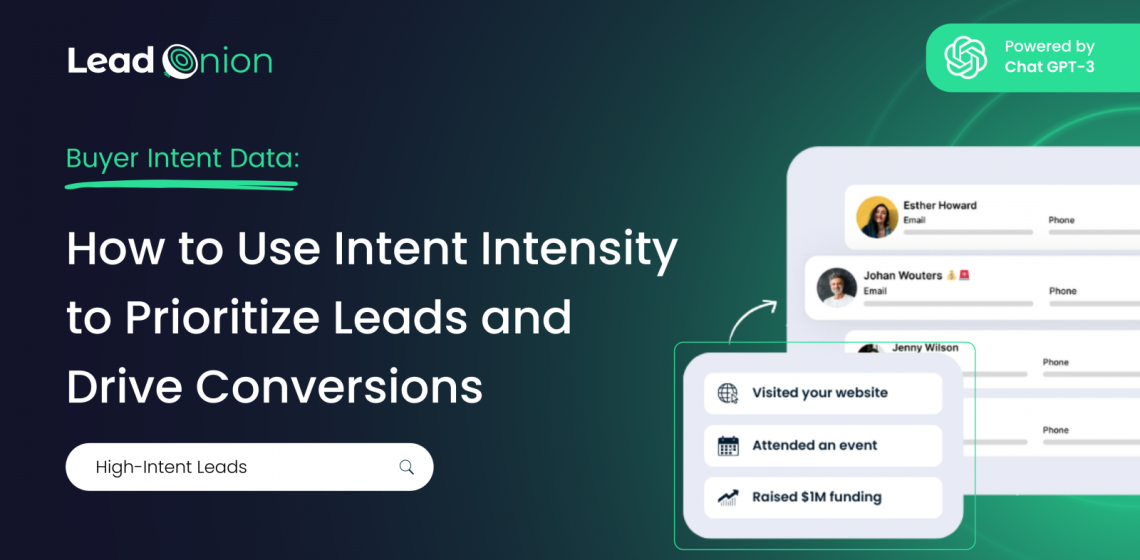Every lead is valuable, but not all leads are created equal. Some prospects are just starting to research solutions, while others are ready to make a purchase. The challenge for businesses is figuring out which leads to prioritize and how to engage them effectively.
This is where intent intensity comes in. By analyzing intent signals such as website visits, content downloads, and competitor comparisons you can identify which prospects show strong buying intent and focus your efforts where they’ll make the biggest impact.
Understanding Intent Intensity
Intent intensity measures the strength of a prospect’s buying signals. High-intensity leads display clear behaviors that indicate they are actively in-market, such as engaging with multiple touchpoints, researching specific solutions, or interacting frequently with your competitors.
Lower-intensity leads might show general interest but lack the behaviors that suggest immediate readiness to purchase. Segmenting leads by intent intensity allows businesses to allocate resources more effectively, prioritizing those most likely to convert while nurturing those still in the earlier stages.

Key Metrics for Assessing Intent Intensity
Prioritizing leads effectively starts with understanding the metrics that reveal a prospect’s level of intent. These insights help your team focus their efforts strategically. Here are four key intent metrics to focus on:
1. Engagement Across Multiple Channels
Leads who interact with your website, open your emails, and engage with your ads demonstrate higher intent than those engaging through a single channel.
2. Depth of Content Interaction
Downloading detailed resources like case studies or attending webinars indicates deeper interest compared to casually reading blogs.
3. Competitive Comparisons
Leads researching your competitors on platforms like G2 or downloading competitor whitepapers are signaling strong buying intent.
4. Frequency and Recency of Interactions
Prospects who engage often and recently are more likely to be in-market compared to those with sporadic or outdated activity.
How to Segment Leads by Intent Intensity
To prioritize leads effectively, you need a clear segmentation process. Categorizing prospects based on their level of intent ensures that your sales and marketing efforts align with each lead’s readiness to buy.
Here’s how to segment leads by intent intensity:
1. Identify Key Intent Signals
Determine the intent signals that matter most to your business, such as website visits, form submissions, or content interactions.
2. Assign Scoring Weights to Signals
Use a scoring system that gives higher weights to behaviors showing strong intent, like competitor research or webinar attendance.
3. Categorize Leads into Tiers
Organize leads into tiers based on their total intent score:
- High-Intent Leads: Ready for immediate sales outreach.
- Medium-Intent Leads: Best suited for nurturing campaigns to move them further along the funnel.
- Low-Intent Leads: Early-stage prospects who need awareness-building efforts.
4. Automate the Process
Use marketing automation tools to score and categorize leads in real time, allowing your team to act quickly on high-priority opportunities.
The Role of Intent Data in Prioritization
Intent data eliminates the guesswork from lead prioritization by giving you a clear view of which prospects are actively researching solutions. Buyer Intent Activation and Intelligence platforms like Lead Onion consolidate intent signals from multiple sources including first-party website data, second-party competitor insights, and third-party topic trends—providing a comprehensive picture of buyer behavior. With this data, businesses can:
- Focus on High-Value Opportunities: Spend less time on cold leads and more time on prospects ready to buy.
- Personalize Outreach: Use intent insights to craft tailored messaging that resonates with a prospect’s specific needs.
- Increase Efficiency: Automate lead scoring and prioritization to streamline workflows and improve team productivity.
Maximize Sales and Marketing Success with Intent Intensity
Lead prioritization is about working smarter, not harder. By focusing on intent intensity, businesses can identify their most promising prospects, optimize their resources, and drive higher conversion rates.
Ready to see how intent data can transform your lead prioritization strategy with Lead Onion?
Meet Aimee, the world’s first AI-powered Buyer Intent Agent, setting you up in just 3 minutes to access 14 days worth of intent-driven leads + 7 days real-time intent data. No setup, no guesswork, just instant activation.


.png)